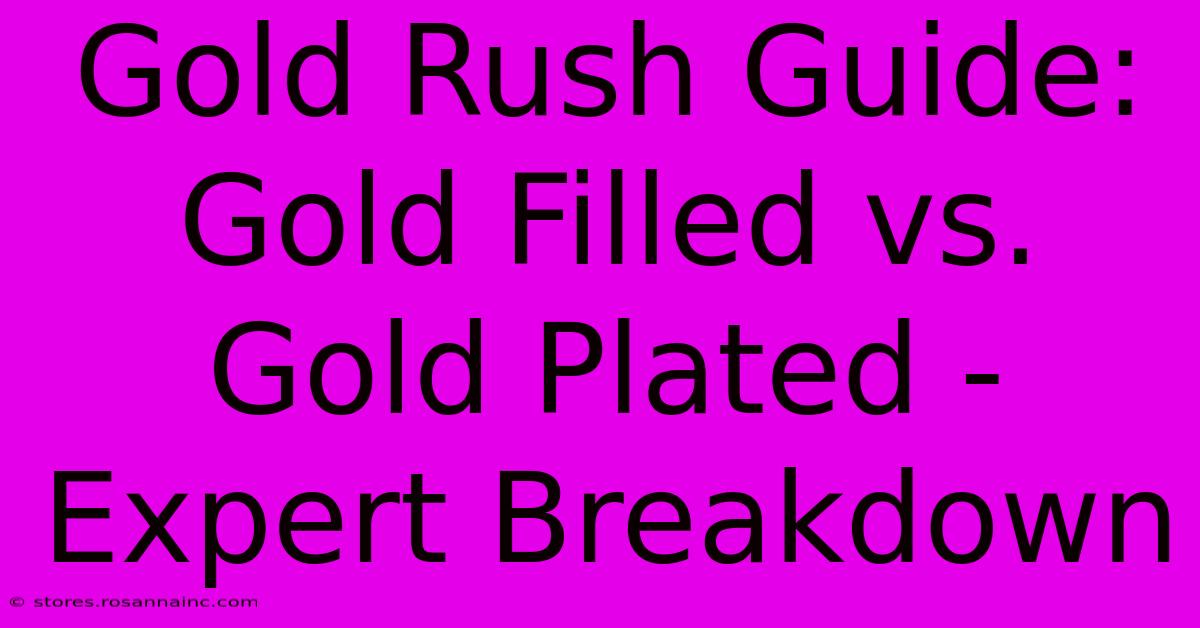Gold Rush Guide: Gold Filled Vs. Gold Plated - Expert Breakdown

Table of Contents
Gold Rush Guide: Gold Filled vs. Gold Plated - Expert Breakdown
The shimmering allure of gold jewelry is undeniable. But navigating the world of gold-plated and gold-filled pieces can be tricky. Understanding the difference between gold filled and gold plated is crucial for making informed purchases that offer both style and lasting value. This comprehensive guide will delve into the specifics, helping you confidently choose the perfect gold jewelry for your needs.
What is Gold Plated Jewelry?
Gold plating is a process where a very thin layer of gold is applied to a base metal, typically brass, copper, or silver. This layer is incredibly thin – often measuring just a few microns. Think of it as a gold "skin" over a different metal core.
Pros of Gold Plated Jewelry:
- Affordability: Gold plating is significantly cheaper than solid gold or even gold filled, making it a budget-friendly option.
- Variety of Colors: You can find gold plating in various colors like yellow, white, and rose gold, offering diverse stylistic choices.
Cons of Gold Plated Jewelry:
- Short Lifespan: The thin layer of gold wears off easily with regular wear and tear, revealing the base metal underneath. This significantly reduces the lifespan of the piece.
- Prone to Tarnish: The exposed base metal is susceptible to tarnishing, requiring more frequent cleaning and potentially losing its shine quickly.
- Not Hypoallergenic: The base metal can cause allergic reactions in individuals sensitive to certain metals.
What is Gold Filled Jewelry?
Gold filled jewelry is a different story. It's constructed with a much thicker layer of gold mechanically bonded to a core metal, usually sterling silver or brass. This layer is substantially thicker than gold plating, typically at least 1/20th of the total item's weight. This means a higher gold content resulting in a longer-lasting piece.
Pros of Gold Filled Jewelry:
- Durability: Because of its thicker gold layer, gold-filled jewelry is far more durable and resistant to wear and tear than gold-plated jewelry. It can last for years with proper care.
- Higher Gold Content: The significantly higher gold content translates to a piece that looks and feels more luxurious.
- Less Prone to Tarnish: While not entirely tarnish-proof, gold-filled jewelry is far less likely to tarnish than gold-plated jewelry.
- More Hypoallergenic: The thicker gold layer minimizes contact with the base metal, making it a better choice for those with metal sensitivities.
Cons of Gold Filled Jewelry:
- Higher Cost: Gold filled jewelry is more expensive than gold plated jewelry, reflecting its higher gold content and durability.
- Less Selection: While the selection is growing, you might find fewer design options compared to gold-plated jewelry.
Gold Filled vs. Gold Plated: The Ultimate Comparison
| Feature | Gold Plated | Gold Filled |
|---|---|---|
| Gold Layer | Very thin (microns) | Significantly thicker (1/20th or more) |
| Durability | Low | High |
| Lifespan | Short | Long |
| Cost | Low | Higher |
| Tarnishing | Prone to tarnishing | Less prone to tarnishing |
| Hypoallergenic | Less likely to be hypoallergenic | More likely to be hypoallergenic |
| Appearance | Can look similar initially | Generally richer, more substantial |
Choosing the Right Option:
Consider your budget, desired lifespan, and potential allergies when choosing between gold filled and gold plated jewelry. For everyday wear and long-lasting jewelry, gold filled is the superior choice. If you're on a tight budget and are okay with replacing your jewelry more frequently, gold plated might suffice for occasional wear.
Caring for Your Gold Jewelry:
Regardless of whether you choose gold-plated or gold-filled jewelry, proper care will extend its lifespan. Store your jewelry in a dry, airtight container or pouch, and avoid exposing it to harsh chemicals or excessive moisture. Regular gentle cleaning with a soft cloth will help maintain its shine.
By understanding the key differences between gold filled and gold plated, you can make an informed decision and enjoy your gold jewelry for years to come. Remember, investing in higher quality often translates to a more valuable and long-lasting piece.

Thank you for visiting our website wich cover about Gold Rush Guide: Gold Filled Vs. Gold Plated - Expert Breakdown. We hope the information provided has been useful to you. Feel free to contact us if you have any questions or need further assistance. See you next time and dont miss to bookmark.
Featured Posts
-
Elevate Your Big Day With Breathtaking Floral Centerpieces
Feb 06, 2025
-
The Perfect Canvas For Your Thoughts Uncover The Benefits Of Custom Printed Journals
Feb 06, 2025
-
Diy Deeper Unraveling The Secret Meaning Behind The Home Depot Logo
Feb 06, 2025
-
Elevate Your Trading Game Snazzy Stock Trader Email Tricks
Feb 06, 2025
-
Roll For Style D And D Nails That Will Make Your Opponents Cry Tears Of Envy
Feb 06, 2025
